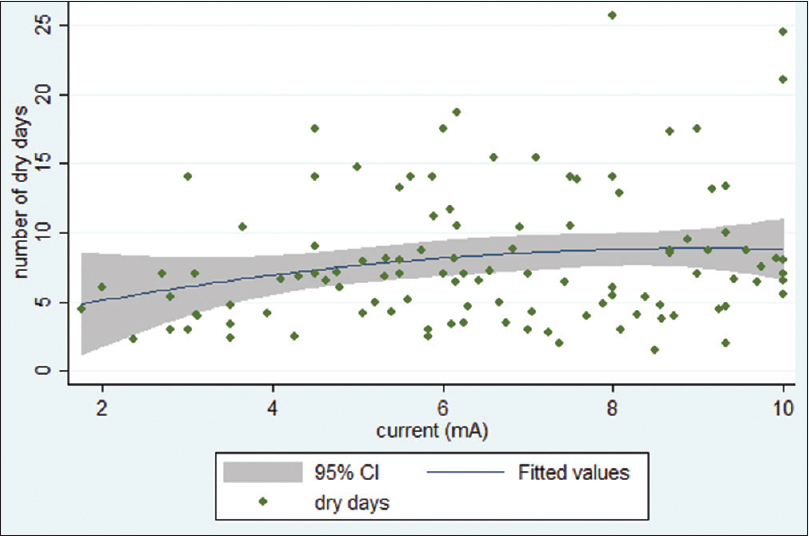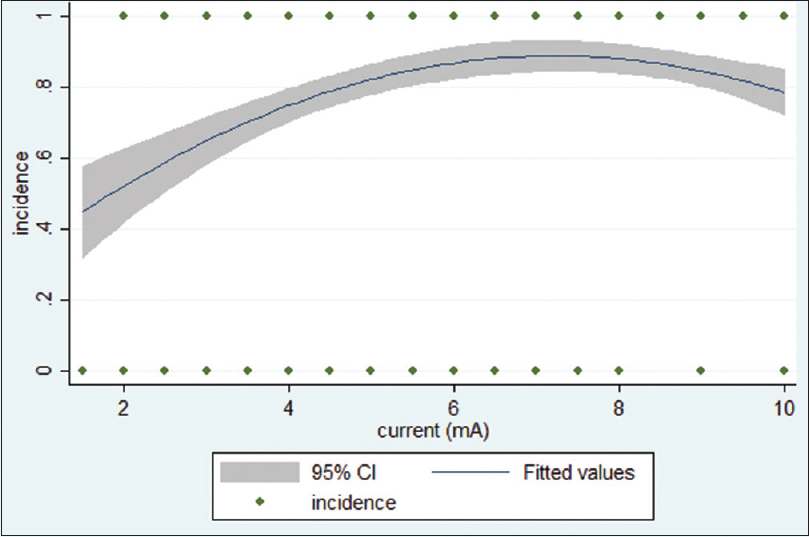Translate this page into:
Treatment of primary palmar hyperhidrosis using glycopyrrolate iontophoresis: Intensity of electrical current used, efficacy and side effects
2 National Skin Centre; Lee Kong Chian School of Medicine, Nanyang Technological University, Singapore
Corresponding Author:
Hong Liang Tey
National Skin Centre, 1 Mandalay Road
Singapore
hltey@nsc.com.sg
| How to cite this article: Leow MQ, Tey HL. Treatment of primary palmar hyperhidrosis using glycopyrrolate iontophoresis: Intensity of electrical current used, efficacy and side effects. Indian J Dermatol Venereol Leprol 2017;83:387-388 |
Sir,
Hyperhidrosis is caused by a dysfunction in the regulation of sweating by the sympathetic nervous system, resulting in a higher production of sweat. It is characterized by excessive sweating, which typically occurs on the palms, soles and axillae.[1] Iontophoresis is a form of electrical stimulation that can treat hyperhidrosis of the hands, feet and axillae.[2] The addition of glycopyrronium bromide, an anticholinergic agent, can increase the effectiveness of this treatment.[3],[4] There are limited studies conducted on the effectiveness of iontophoresis in the treatment of hyperhidrosis. The aim of this study was to evaluate and correlate the intensity of electrical current used with the efficacy and side effects of the treatment with glycopyrronium bromide iontophoresis, in primary palmar hyperhidrosis.
In this retrospective cohort study, patients with primary palmar hyperhidrosis who received iontophoresis treatment between July and October, 2014 (12 weeks), at the National Skin Centre, Singapore, were included. The details were obtained from the electronic medical records. All patients who received more than one iontophoresis treatment on the hands during the study period were included in the analysis. The study was approved by the institution's ethics review board. Iontophoresis was performed using Ionos 7 freeline (manufactured by Nemectron in Germany) in alternating current. The anode was filled with glycopyrronium bromide 0.04% solution and the tray containing the cathode was filled with tap water. After the patient immersed his/her hands in each tray, an alternating electrical current was started and increased to a level where he/she reported a tingling sensation on the hands, up to a maximum of 10 mA. Each hand was immersed in the solution for 10 min. Clinical data collected included the intensity of the electrical current, efficacy and side effects. Intensity of the electrical current that was delivered was measured to the nearest 0.5 mA. Efficacy was assessed by the number of palmar dry days reported by the patients, measured to the nearest whole day. The type, extent (localized or systemic), severity (mild or severe) and duration of the side effects were also recorded. The duration of side effects was measured to the nearest whole day. The data were analyzed using StataCorp. 2013 (Stata Statistical Software: Release 13. College Station, TX: StataCorp LP).
There were 604 sessions of iontophoresis performed in 114 patients, during the study period. The mean age of the patients was 31.1 ± 12.2 (range, 9–65) years and 78 (68.4%) of the patients were men. The ethnic distribution was diverse, which comprised of 100 Chinese (87.7%), 1 Malay (0.9%), 11 Indians (9.6%) and 2 (1.8%) other races. During the study period, the patients attended a mean of 5.3 ± 2.7 (range, 2–12) iontophoresis treatment sessions. They experienced an average of 7.3 ± 4.7 (range, 0–28) palmar dry days. Eight patients (7.0%) had one experience of 0 dry days. The mean current used was 6.7 ± 2.4 mA (range, 1.5–10.0). No patient reported any serious side effects or side effects localized to the hands. Mild systemic side effects (mouth and/or throat dryness) were reported in at least one treatment in 107 (93.9%) patients. The side effects were present in 488 (80.8%) treatment sessions and they lasted for 0.9 ± 0.6 (range, 0–3) days.
Analysis using generalized estimating equation revealed that the intensity of the electrical current used correlated positively with the duration of palmar dryness (Z = 10.92, P< 0.001) and the incidence of side effects (Z = 4.86, P< 0.001), but not the duration of side effects (Z = −0.57, P= 0.57) [Table - 1]. A plot of current intensity versus number of dry days showed an initial linear effect with the number of dry days increasing from 5 to 8.5 days when the current intensity was increased from 2 to 8 mA, respectively, but a plateau effect was observed subsequently [Figure - 1]. A plot of incidence of side effects versus current intensity showed an incremental trend until 7 mA and not thereafter, at higher intensities [Figure - 2].

 |
| Figure 1: Plot diagram of number of dry days vs intensity of current |
 |
| Figure 2: Plot diagram of incidence of side effects vs intensity of current |
To conclude, in this study, increasing current intensities from 2.0 to 8.0 mA resulted in more number of dry days. The plateau after 8.0 mA suggest that there is a limit to increasing the efficacy with increasing current intensity. On an average, the patients experienced dry days for a week and had to return weekly for treatment, to maintain their palmar dryness. The incidence of mild systemic side effects, such as mouth and throat dryness, was high, with the vast majority of patients experiencing them after the treatment. Higher current intensities were also found to be associated with a higher incidence of side effects, but did not have any impact on the duration of side effects. There is maximal effect of the intensity of electric current in glycopyrronium bromide iontophoresis, at around 7.5–8.0 mA, in this study.
Acknowledgment
The authors would like to thank Associate Professor Chan Moon Fai and Ms. Virlynn Tan for their statistical advice.
Financial support and sponsorship
Nil.
Conflicts of interest
There are no conflicts of interest.
| 1. | Adar R, Kurchin A, Zweig A, Mozes M. Palmar hyperhidrosis and its surgical treatment: A report of 100 cases. Ann Surg 1977;186:34-41. [Google Scholar] |
| 2. | Dahl JC, Glent-Madsen L. Treatment of hyperhidrosis manuum by tap water iontophoresis. Acta Derm Venereol 1989;69:346-8. [Google Scholar] |
| 3. | Abell E, Morgan K. The treatment of idiopathic hyperhidrosis by glycopyrronium bromide and tap water iontophoresis. Br J Dermatol 1974;91:87-91. [Google Scholar] |
| 4. | Dolianitis C, Scarff CE, Kelly J, Sinclair R. Iontophoresis with glycopyrrolate for the treatment of palmoplantar hyperhidrosis. Australas J Dermatol 2004;45:208-12. [Google Scholar] |
Fulltext Views
5,461
PDF downloads
2,173





